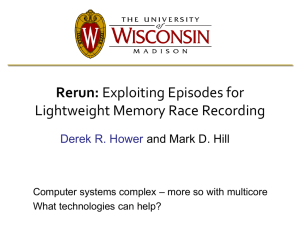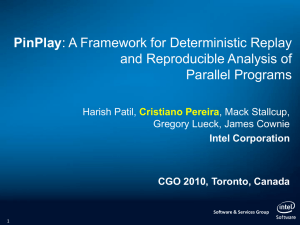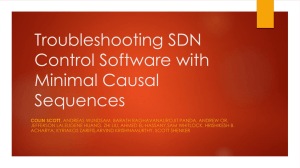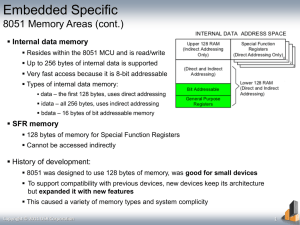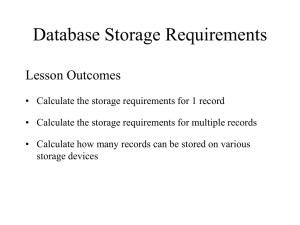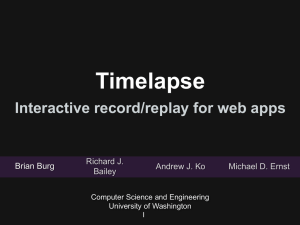Slide 1
advertisement
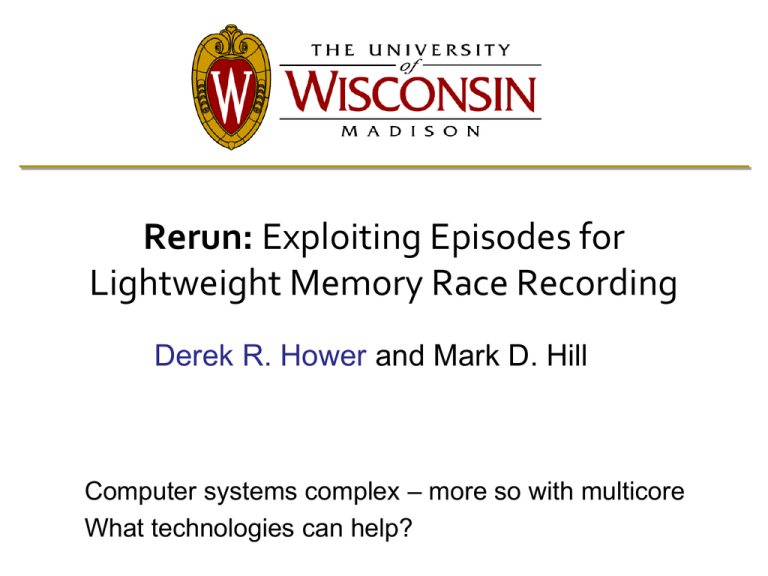
Rerun: Exploiting Episodes for
Lightweight Memory Race Recording
Derek R. Hower and Mark D. Hill
Computer systems complex – more so with multicore
What technologies can help?
Executive Summary
• State of the Art
–
–
–
–
Deterministic replay can help
Uniprocessor replay can be done in hypervisor
Multiprocessor replay must record memory races
Existing HW race recorders
• Too much state (e.g., 24KB ) or don’t scale to many processors
• We Propose: Rerun
–
–
–
–
Record Memory Races? NO
Record Lack of Memory Races – An Episode
Best log size (like FDR-2): 4 bytes/1000 instructions
Best state (like Strata-snoop) : 166 bytes/core
2
Outline
• Motivation
– Deterministic Replay
– Memory Race Recording
•
•
•
•
Episodic Recording
Rerun Implementation
Evaluation
Conclusion
3
Deterministic Replay (1/2)
• Deterministic Replay
– Faithfully replay an execution such that all instructions appear to
complete in the same order and produce the same result
• Valuable
– Debugging [LeBlanc, et al. - COMP ’87]
• e.g., time travel debugging, rare bug replication
– Fault tolerance [Bressoud, et al. - SIGOPS ‘95]
• e.g., hot backup virtual machines
– Security [Dunlap et al. – OSDI ‘02]
• e.g., attack analysis
– Tracing [Xu et al. – WDDD ‘07]
• e.g., unobtrusive replay tracing
4
Deterministic Replay (2/2)
• Implementation: Must Record Non-Deterministic Events
– Uniprocessors: I/O, time, interrupts, DMA, etc.
– Okay to do in software or hypervisor
• Multiprocessor Adds: Memory Races
– Nondeterministic
– Almost any memory reference could race Record w/ HW?
T0
X=0
if (X > 0)
Launch Mark
T1T0
X=0
X=5
if (X > 0)
Launch Mark
T0
T1
X=5
X=0
if (X > 0)
Launch Mark
T1
X=5
5
Memory Race Recording
• Problem Statement
– Log information sufficient to replay all memory races in the same
order as originally executed
• Want
– Small log – record longer for same state
– Small hardware – reduce cost, especially when not used
– Unobtrusive – should not alter execution
• State of the Art
–
–
–
–
Wisconsin Flight Data Recorder 1 & 2 [ISCA’03 & ASPLOS’06]
4 bytes/1000 instructions log but 24 KB/processor
UCSD Strata [ASPLOS’06]
0.2 KB/processor, but log size grows rapidly with more cores
6
Outline
• Motivation
• Episodic Recording
– Record lack of races
• Rerun Implementation
• Evaluation
• Conclusion
7
Episodic Recording
• Most code executes without races
– Use race-free regions as unit of ordering
• Episodes: independent execution regions
– Defined per thread
– Identified passively does not affect execution
– Encompass every instruction
T0
LD
ST
ST
LD
LD
LD
ST
ST
LD
A
B
C
F
X
Q
Q
C
Z
T1
ST
LD
ST
LD
ST
ST
ST
ST
T2
E
B
X
R
T
C
E
X
ST
ST
LD
LD
LD
LD
V
Z
W
J
J
V
8
Capturing Causality
• Via scalar Lamport Clocks [Lamport ‘78]
– Assigns timestamps to events
– Timestamp order implies causality
• Replay in timestamp order
– Episodes with same timestamp can be replayed in parallel
T0
T1
T2
43
22
44
23
23
44
62
45
60
61
9
Episode Benefits
• Multiple races can be captured by a single episode
– Reduces amount of information to be logged
• Episodes are created passively
– No speculation, no rollback
• Episodes can end early
– Eases implementation
• Episode information is thread-local
– Promotes scalability, avoids synchronization overheads
10
Outline
• Motivation
• Episodic Recording
• Rerun Implementation
– Added hardware
– Extensions & Limitations
• Evaluation
• Conclusion
11
Hardware
• Rerun requirements:
– Detect races track r/w sets
– Mark episode boundaries
– Maintain logical time Base System
L2
… L2
14
15
Total State: 166 bytes/core
L2
1
DRAM
DRAM
L2
0
Interconnect Memory Timestamp(MTS)
Core
0
Core
1
…
Core
14
Core
15
32 bytes
4 bytes
Write Filter (WF)
Read Filter (RF)
References (REFS)
Timestamp (TS) 128 bytes
12
2
bytes
4 bytes
Putting it All Together
R: {}
{A}
W: {}
{F}
{F,B}
REFS: 0
1
2
3
4
TS:
44
TS: 43
A
B
…
REFS: 16
TS: 42
ST F
LD A
ST B
F
R: {R,F}
{}
{R}
W: {T,B}
{}
{T}
REFS: 4
0
1
2
3
TS: 45
6
44
…
REFS: 97
TS: 5
LD R
ST T
LD F
ST B
ST F
Thread 0
R
T
Thread 1
13
Implementation Recap
• Bloom filters to track read/write set
– False positives O.K.
• Reference counter to track episode size
• Scalar timestamps at cores, shared memory
• Piggyback timestamp data on coherence responses
• Log episode duration and timestamp
14
Extensions & Limitations
• Extensions to base system:
–
–
–
–
SMT
TSO, x86 memory consistency models
Out of Order cores
Bus-based or point-to-point snooping interconnect
• Limitations:
– Write-through private cache reduces log efficiency
– Mostly sequential replay
– Relaxed/weak memory consistency models
15
Outline
•
•
•
•
Motivation
Episodic Recording
Rerun Implementation
Evaluation
– Methodology
– Episode characteristics
– Performance
• Conclusion
16
Methodology
• Full system simulation using Wisconsin GEMS
– Enterprise SPARC server running Solaris
• Evaluated on four commercial workloads
– 2 static web servers (Apache and Zeus)
– OLTP-like database (DB2)
– Java middleware (SpecJBB2000)
• Base system:
– 16 in-order core CMP
– 32K 4-way write-back L1, 8M 8-way shared L2
– MESI directory protocol, sequential consistency
17
Episode Characteristics
-Use perfect (no false positive) Bloom filters, unlimited resources
Episode Length CDF
~64K
2 byte REFS counter
Write Set Size
70
Read Set Size
113
Filter Sizes: 32 & 128 bytes
18
# dynamic memory refs
# blocks
# blocks
Log Size
6
Bytes/Kilo-instr
5
4
3
2
1
0
Apache
JBB
OLTP
Zeus
Avg
~ 4 bytes/1000 instructions uncompressed
19
Comparison – Log Size
58
30
108
Bytes/Kilo-instr
25
20
15
10
5
0
2p
4p
Rerun
FDR-2
8pStrata
Good Scalability
16p
20
Comparison – Hardware State
1000
KBytes
800
600
400
200
0
0
10
20
FDR-2
30
40
50
# cores
Strata
Rerun
60
Good Scalability and Small Hardware State
21
Conclusion
• State of the Art
–
–
–
–
Deterministic replay can help
Uniprocessor replay can be done in hypervisor
Multiprocessor replay must record memory races
Existing HW race recorders
• Too much state (e.g., 24KB ) & don’t scale to many processors
• We Propose: Rerun – Replay Episodes
– Record Lack of Memory Races
– Best log size (like FDR-2): 4 bytes/1000 instructions
– Best state (like Strata-snoop) : 166 bytes/core
22
QUESTIONS?
23
Delorean vs. Rerun
Delorean
Rerun
Ordering
Sequential
Distributed
Extensibility
Low
High
Log Size
Very Small
Small
Replay
Mostly Parallel
Mostly Sequential
24
From 10,000 Feet
• Rerun is a lightweight memory race recorder
– One part of full deterministic replay system
• Rerun in HW, rest in HW or SW
User Application
Operating System
SW
Hypervisor
HW
Cache Controller
Private Log
Input Logger
Rerun
Pipeline
25
Adapting to TSO
• Violation in TSO…Given block B:
– B in write buffer, and
– Bypassed load of B occurred, and
– Remote request made for B before it leaves the write
buffer
• On detection, log value of load
– Or, log timestamp corresponding to correct value
• Believe this works for x86 model as well
26
Detecting SC Violations - Example
WAR
Value
Omitted
Thread
I
Thread J
Logged
A=B=0
1 st A,1
2
st B,1 1
ld B
ld A
1 st A,1
2
ld B
Replay
Thread
J
A Changed!
st B,1 1
ld A
B=1J
WrBuf WrBuf
2
Recording
Thread I
I A=1
2
Value Used
A=0
st A,1
st B,1
ld A
ld B
st A,1
st B,1
Memory System
A=0
A=0
B=0
B=0
J StartsIto
I
Starts
Stopsto
Monitor
Monitoring
Monitor
A
BB
*animation from Min Xu’s thesis defense
27
Flight Data Recorder
• Full system replay solution
• Logs all asynchronous events
– e.g. DMA, interrupts, I/O
• Logs individual memory races
– Manages log growth through transitive reduction
• i.e. races implied through program order + prior logged race
– Requires per-block last access memory
– State for race recording: ~24KByte
– Race log growth rate: ~1byte/kiloinst compressed
28
Strata
• Creates global log on
race detection
– Breaks global execution
into “stratums”
– A stratum between every
inter-thread dependence
• Most natural on
bus/broadcast
• Logs grow proportional
to # of threads
29
Bloom Filters
• Three design dimensions
• Hash function
• Array size
• # hashes
30
